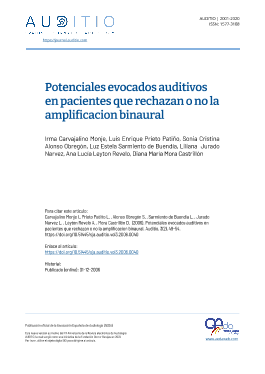Auditory evoked potentials in patients who reject or not binaural amplification
DOI:
https://doi.org/10.51445/sja.auditio.vol3.2006.0040Keywords:
brainstem evoked response audiometry (BERA), binaural amplification, age-related hearing loss, hearing aidsAbstract
A comparative descriptive study was carried out to determine the significant differences in the Short-Latency Auditory-Evoked Potentials that could, through the analysis of various variables, determine the reason why patients older than 65 years, with average sensorineural hearing loss up to 70 - 80 dB reject binaural amplification at the Institute for Blind and Deaf Children in the city of Cali, in 2005. An intentional sample of 40 patients with binaural adaptation of at least three months was taken, of which 20 rejected hearing aids and 20 no. The study allowed to detect that in the latency results of Waves I, III and V, the interpeak latencies I - III, III - V, I - V and the interaural difference of wave V, using a click stimulus, varying the Stimulus velocity of 11 p / sec and 77 p / sec, and the polarity of the stimulus in Rarefaction and Condensation in each of the ears presented values that do not deviate from normal, for the population under study; This also happened in the auditory functionality in the two groups of patients in different daily situations presented in the modified HHIE questionnaire. The study showed that there are no significant differences between the two study groups, which was verified using the Mann-Whitney U test, that is, the BERA electrophysiological test does not provide information that allows determining whether a patient older than 65 years with sensorineural hearing loss between 70 and 80 dB it will adapt to binaural amplification.
Downloads
Visibility and Altmetrics
Metrics
Global Statistics ℹ️
|
1652
Views
|
2189
Downloads
|
|
3841
Total
|
|
References
Rangel, M. (2001). Amplificación, un reto en evolución. Acta de Otorrinolaringología & Cirugía de cabeza y Cuello 30 (2).
Bray, V., Nilsson, M. (2005). A new definition for modern hearing aids. Recuperado Julio 15 de 2005, de https://www.audiologyonline.com/articles/new-definition-for-modern-hearing-1036
American Speech-Language and Hearing Association (1998). Perspectives guidelines for hearing aid fitting for adults. American Journal of Audiology, 7 (1). https://doi.org/10.1044/1059-0889.0701.05
Carvajal, G., Charry, M., Salguero, M. (1984). Estudio audiolinguistico en la elaboración de una lista de palabras fonéticamente balanceadas para logoaudiometría en Colombia. Tesis sin editar. Universidad Nacional de Colombia. Bogotá D.C..
Escobar, M., Granados, O. Pulido, S. (1989). Iniciación de la validez concurrente de una lista de palabras para la logoaudiometría. Tesis no publicada. Universidad Nacional de Colombia, Bogotá.
Oramas, C., Rodríguez, W., Bilbao, L., Ciro, C., González, A., González, L (2004). Traducción y adaptación de la Escala HHIE dirigida a población adulta mayor. Informe de Investigación Institucional, Corporación Universitaria Iberoamericana. Bogotá D.C.
Burkard, R. Sims, D. (2001). The Human Auditory Brainstem response to High Click Rates: Aging Effects. American Journal of Audiology, 10 (2) https://doi.org/10.1044/1059-0889(2001/008)
Ballachanda,B. Crawford, M. Ferraro, J. & Griffiths, S. (2004). Auditory Evoked Potentials. American Speech-Language and Hearing Association.
Berlin, C., Hood, L., Morlet, T. (2003). Auditory neuropathy / dyssynchrony. Its diagnosis and management. Estados Unidos: The Pediatric Clinics of North America, No. 50. https://doi.org/10.1016/S0031-3955(03)00031-2
Jacobson, J. (1994). Principles applications in auditory evoked potentials. Massachussetts, Estados Unidos: Allyn and Bacon.
Purdy, J. (2001). Hearing Loss Associated with Aging. Recuperado el 24 de junio de 2004, de http:// www.helathyhearing.com /article/asp?id=19& catid= 1053
Bellis, T. (2002). When the brain can't hear. New York, Estados Unidos: Pocket Books.

Published
Versions
- 2021-09-15 (2)
- 2006-12-01 (1)
How to Cite
Issue
Section
License
Copyright (c) 2006 Auditio

This work is licensed under a Creative Commons Attribution 3.0 Unported License.
All articles will be published under the open Creative Commons Attribution (CC-BY) license. This license allows others to share and adapt the content, even for commercial purposes, as long as appropriate credit is given to the authors and the journal. By submitting their manuscript, authors retain copyright but grant the journal the right to make the first publication under this license.
More information about this license is available at: https://creativecommons.org/licenses/by/4.0/
Articles published between 2001 and 2020
The texts published in this journal in the section "AUDITIO 2001-2020" are subject - unless otherwise indicated - to a Creative Commons Attribution 3.0 Spain license. You can copy, distribute, communicate them publicly, make derivative works and commercial uses provided that you acknowledge the credits of the works (authorship, name of the journal, publishing institution) in the manner specified by the authors or by the journal. The full license can be consulted at http://creativecommons.org/licenses/by/3.0/es/deed.es.









